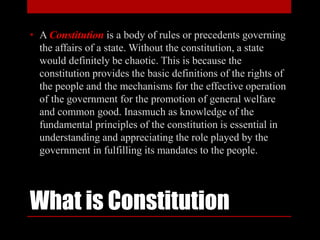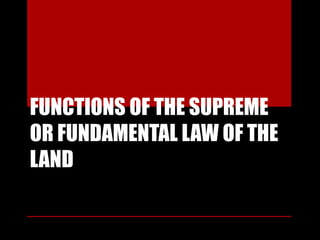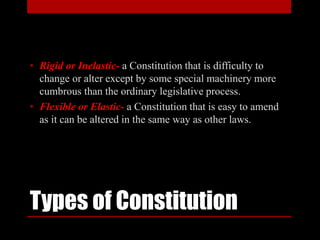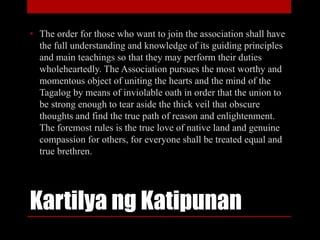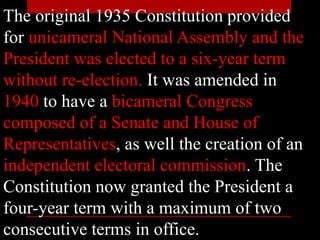Introduction to constitution
- 2. What is Constitution • A Constitution is a body of rules or precedents governing the affairs of a state. Without the constitution, a state would definitely be chaotic. This is because the constitution provides the basic definitions of the rights of the people and the mechanisms for the effective operation of the government for the promotion of general welfare and common good. Inasmuch as knowledge of the fundamental principles of the constitution is essential in understanding and appreciating the role played by the government in fulfilling its mandates to the people.
- 3. FUNCTIONS OF THE SUPREME OR FUNDAMENTAL LAW OF THE LAND
- 4. 1. Establishment of the basic framework of the Government • The Constitution identifies and regulates the specific powers and functions of the executive, legislative, and judicial branches of the government. There is a need to regulate the government’s exercise of its sovereign powers to preclude it from becoming despotic, oppressive, and tyrannical.
- 5. 2. Regulation of the rights and freedoms enjoyed by the individuals for the common good • This is very important function served by a constitution. If people’s exercise of their liberties is not regulated, there shall be chaos, anarchy, and public disorder.
- 6. Protection of the people from government abuses Our constitution, for instance, protects the people from the possible abuses by the government through the following means. • By ensuring that each branch of government exercise only the power conferred to it by the constitution; • By prohibiting the government from exercising powers infringing the declaration of principles and state policies; and… • By specifying the basic rights of the people, which the government has to respect and safeguard.
- 7. Types of Constitution • Enacted or Conventional- a constitution is drafted and passed by a constituent assembly or granted by a sovereign to the people. • Evolved or Cumulative- a constitution which is the product of a long history of usage by customs, traditions, and judicial decisions rather than by formal or deliberate enactment.
- 8. Types of Constitution • Written- a Constitution either granted by a ruler, or enacted by the legislature or framed by a constituent body and ratified by the people. • Unwritten- a Constitution that consists of customs, usages, legal traditions, and statutory legislations and is entirely the product of political growth and development
- 9. Types of Constitution • Rigid or Inelastic- a Constitution that is difficulty to change or alter except by some special machinery more cumbrous than the ordinary legislative process. • Flexible or Elastic- a Constitution that is easy to amend as it can be altered in the same way as other laws.
- 10. Requisites of a good written Constitution • Broadness- Inasmuch as the constitution has to outline the organization of the government, it has to be comprehensive to embody all the essential functions and powers of the government. • Brevity- The constitution has to be brief but concise. It should not be too lengthy or detailed as the only the essentials of government should be embodied in it. Appropriate statuses will provide the details so the brevity is not violated or debased. • Definiteness- The provisions of the supreme charter of land should be definite and clear to avoid errors and ambiguity in their interpretation.
- 11. DIFFERENT CONSTITUTION OF THE PHILIPPINES
- 12. The Code of Kalantiaw • The Code of Rajah Kalantiaw was a supposed legal code in the epic history Maragtas that is said to have been written in 1433 by Datu Kalantiaw, a chief on the island of Negros in the Philippines. The code is now believed by many historians to have been a hoax and that it had actually been written in 1913 by Jose E. Marco as a part of his historical fiction Las antiguas leyendas de la Isla de Negros (English: The Ancient Legends of the Island of Negros), which he attributed to a priest named Jose Maria Pavon. • Philippine historian Teodoro Agoncillo describes the code as "a disputed document." Despite doubts on its authenticity, some history texts continue to present it as historical fact
- 13. Kartilya ng Katipunan • The order for those who want to join the association shall have the full understanding and knowledge of its guiding principles and main teachings so that they may perform their duties wholeheartedly. The Association pursues the most worthy and momentous object of uniting the hearts and the mind of the Tagalog by means of inviolable oath in order that the union to be strong enough to tear aside the thick veil that obscure thoughts and find the true path of reason and enlightenment. The foremost rules is the true love of native land and genuine compassion for others, for everyone shall be treated equal and true brethren.
- 14. Malolos Constitution • The Political Constitution of 1899 (Spanish: Constitución Política de 1899), informally known as the Malolos Constitution, was the basic law of the First Philippine Republic. It was written by Felipe Calderón y Roca and Felipe Buencamino as an alternative to a pair of proposals to the Malolos Congress by Apolinario Mabini and Pedro Paterno. After a lengthy debate in the latter part of 1898, it was promulgated on 21 January 1899
- 15. The 1935 Philippine Constitution • The 1935 Constitution was written in 1934, approved and adopted by the Commonwealth of the Philippines (1935– 1946) and later used by the Third Republic (1946–1972). It was written with an eye to meeting the approval of the United States Government as well, so as to ensure that the U.S. would live up to its promise to grant the Philippines independence and not have a premise to hold onto its possession on the grounds that it was too politically immature and hence unready for full, real independence.
- 16. The original 1935 Constitution provided for unicameral National Assembly and the President was elected to a six-year term without re-election. It was amended in 1940 to have a bicameral Congress composed of a Senate and House of Representatives, as well the creation of an independent electoral commission. The Constitution now granted the President a four-year term with a maximum of two consecutive terms in office.
- 17. 1973 Constitution The 1973 Constitution, according to former Aquino spokesman Teodoro Locsin Jr, was never ratified as the process conducted by then president Ferdinand Marcos met strong opposition. The Aquino government had 3 options with regard to the law of the land: • To revert to the 1935 Constitution. But because Marcos abolished the bicameral legislature they had to resort to general elections. • To retain the 1973 Constitution and be granted the power to make reforms. This was shot down by Aquino as "she did not want to derive legitimacy and power from the very institutions that she fought." • To start anew and break from the "vestiges of a disgraced dictatorship.
- 18. 1987 Philippine Constitution • Ruling by decree during the early part of her tenure and as a president installed via the People Power Revolution, President Corazon Aquino issued Proclamation No. 3 on March 25, 1986 which abrogated many of the provisions of the then 1973 Constitution adopted during the Marcos regime including the unicameral legislature (the Batasang Pambansa), the office of Prime Minister, and provisions which gave the President legislative powers. Often called the "Freedom Constitution," this constitution was only intended as a temporary constitution to ensure the freedom of the people and the return to democratic rule. A constitutional commission was soon called to draft a new constitution for the country.
- 19. 1987 Philippine Constitution • The Constitutional Commission was composed of fifty members appointed by Aquino from varied backgrounds including several former members of the House of Representatives, former justices of the Supreme Court, a Roman Catholic bishop, and political activists against the Marcos regime. The Commission elected Cecilia Muñoz-Palma, a former Associate Justice of the Supreme Court, as its president. Several issues were of particular contention during the Commission's sessions, including the form of government to adopt, the abolition of the death penalty, the retention of the U.S. bases in Clark and Subic, and the integration of economic policies into the constitution. Lino Brocka, a film director and political activist who was member of the Commission, walked out before the constitution's completion, and two other delegates dissented from the final draft. The Commission finished the final draft on October 12, 1986 and presented it to Corazon Aquino on October 15. The constitution was ratified by a nationwide plebiscite on February 8, 1987.
- 20. The Preamble • We, the sovereign Filipino people, imploring the aid of Almighty God, in order to build a just and humane society, and establish a Government that shall embody our ideals and aspirations, promote the common good, conserve and develop our patrimony, and secure to ourselves and our posterity, the blessings of independence and democracy under the rule of law and a regime of truth, justice, freedom, love, equality, and peace, do ordain and promulgate this Constitution.
- 21. Announcement… •We will be having a Quiz (Yes you’ve read it right!) on Wednesday, next week! So review your book regarding this topic or get this PowerPoint presentation through me.

